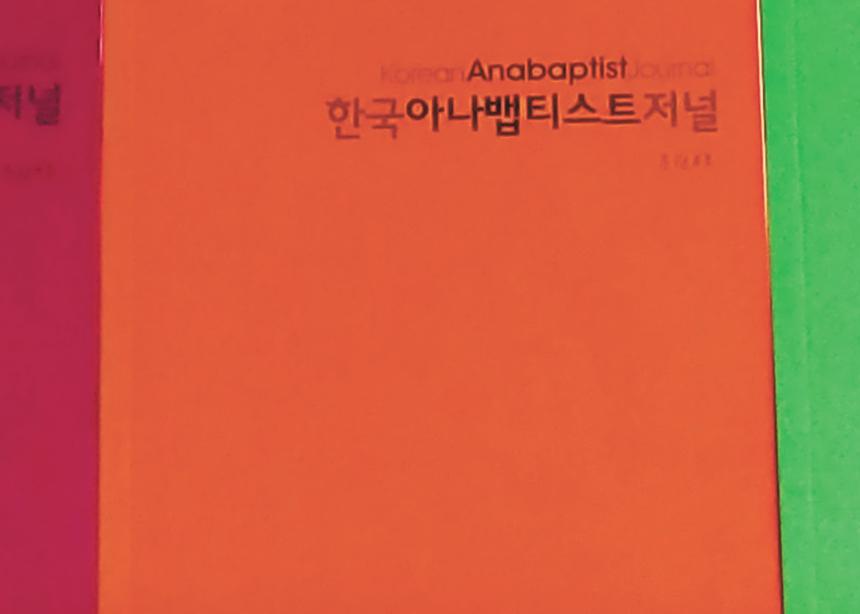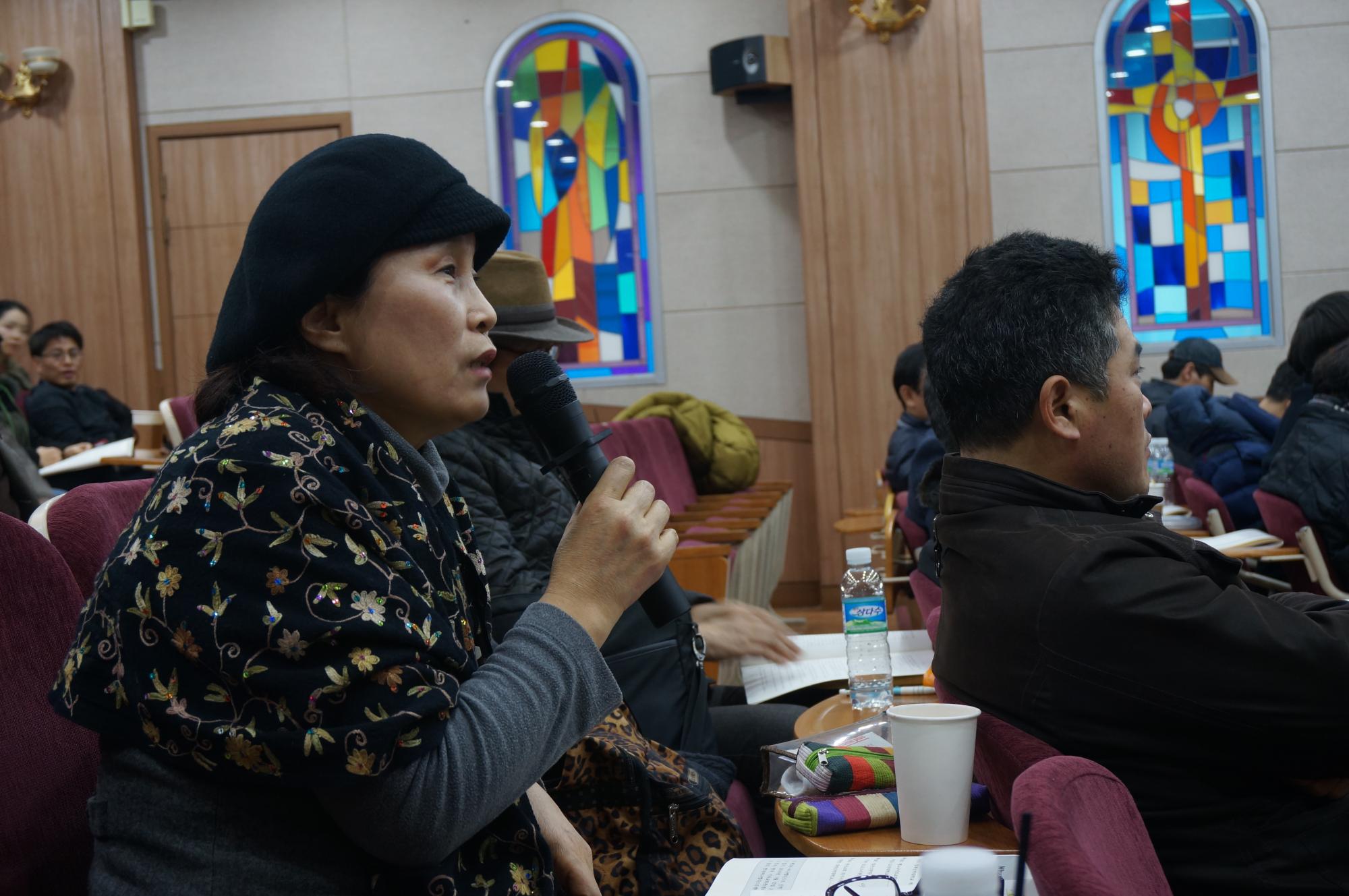Journal connects Korean Anabaptists across the globe | Canadian Mennonite Magazine
Journal connects Korean Anabaptists across the globe

October 23, 2019 | Focus On Books & Resources | Volume 23 Issue 19
Katie Doke Sawatzky | Mennonite Church Canada

Korean Anabaptist Journal
Eight years ago this fall, a group of 10 Korean Mennonites met at Sherbrooke Mennonite Church in Vancouver and decided to start a magazine. The publication would be a resource for Korean Anabaptists around the world and connect them to one another.
Nov.17, 2019, marks the seventh anniversary of the first issue of the Korean Anabaptist Journal, a semi-annual magazine published by a volunteer editorial team primarily made up of leaders from Mennonite churches in South Korea.
 In 2010, Mennonite Church Canada International Witness worker Bock Ki Kim noticed a desire from Korean Anabaptist groups in South Korea, Los Angeles, Calif., and Canada, to share resources and network with each other. While the Korea Anabaptist Center in Chuncheon offered resources, Kim saw the need to have a tool to share news and resources on a regular basis.
In 2010, Mennonite Church Canada International Witness worker Bock Ki Kim noticed a desire from Korean Anabaptist groups in South Korea, Los Angeles, Calif., and Canada, to share resources and network with each other. While the Korea Anabaptist Center in Chuncheon offered resources, Kim saw the need to have a tool to share news and resources on a regular basis.“I wanted to create a communication tool for scattered Korean Anabaptists here and there,” says Kim, who was editor of the journal from 2013 to 2016. “Korean church leaders and staff don’t have the time or resources to develop this, and yet leaders are regularly asked by newcomers . . . for a way to connect with others. We needed a way to share information.”
Kim has translated 35 Anabaptist works into Korean in response to a burgeoning interest in Anabaptism by Christians and non-Christians in South Korea. According to him, narrow perspectives of God, corrupt leadership in hierarchical structures and a younger generation disinterested in maintaining physical church buildings, are motivating people to seek fresh perspectives of God and what it means to be the church.
“Peace theology, church as a faith community, restorative justice, conflict transformation, [and] new ways of biblical interpretation, like hermeneutical community,” are some Anabaptist principles that are appealing, he says.
The journal is published by the Korean Anabaptist Fellowship, both in hardcopy and in a PDF format that is shared through social media. An editorial team decides the content for each issue and contacts contributors.
 Hyejung Jessie Yum has been an editor of the journal for the past three years. She is a doctoral student at the Toronto School of Theology and attends Danforth Mennonite Church in Toronto. She is a Korean migrant living in Canada, so regular participation as an editor has allowed her to connect Mennonite faith to her Korean identity and context.
Hyejung Jessie Yum has been an editor of the journal for the past three years. She is a doctoral student at the Toronto School of Theology and attends Danforth Mennonite Church in Toronto. She is a Korean migrant living in Canada, so regular participation as an editor has allowed her to connect Mennonite faith to her Korean identity and context.“The journal gives me an opportunity to think about what Korean Mennonites’ unique voices in our contexts are, and what Mennonite peace theology from Korean perspectives looks like,” says Yum. “These questions relate to my current research focus on postcolonial peace theology in a multicultural context, from a Korean migrant woman’s perspective.”
Inter-Korean relations, refugees on Jeju Island, restorative justice for school bullying and eco-friendly farming are some of the topics the journal has covered recently, all from an Anabaptist perspective, says Yum.
 Jongyoon Moon, pastor of Jeongin Presbyterian Church in Bucheon, in the Gyeonggi Province of South Korea, learned very little about the Anabaptists in his theological training both in Korea and in Texas at the Baptist Theological Seminary.
Jongyoon Moon, pastor of Jeongin Presbyterian Church in Bucheon, in the Gyeonggi Province of South Korea, learned very little about the Anabaptists in his theological training both in Korea and in Texas at the Baptist Theological Seminary. “I only knew about them as radical religious reformers,” Moon writes in an e-mail.
He was searching for a model of church that was true to the New Testament when he learned about the Amish, but he found the lifestyle hard to emulate in urban Korean society. When he learned about the Mennonite church, he wanted to know more. He connected with the Korean Anabaptist Fellowship and met Kim.
“What I learned through the Anabaptist-Mennonite church was the spirit of mutual aid and mutual accountability in the church,” Moon writes. “Today, modern city churches, especially Korean churches, are sadly losing the spirit of mutual aid and mutual accountability the New Testament stresses.”
He credits the Korean Anabaptist Journal with pointing him towards New Testament models of the early church. His own congregation is now putting aside a portion of its offerings each month to help members who experience economic hardship, a practice inspired by his Anabaptist readings.
Along with benefitting pastors and seminary students, Kim hopes the journal will be helpful for newcomers to Anabaptism. That’s why the editors also introduce readers to organizations like Mennonite Central Committee and Mennonite Disaster Service, and partner organizations like Christian Peacemaker Teams.
Kim says the most challenging thing with running the journal is finding the time and resources to publish it. While it started out as a quarterly, the journal is now published twice a year. The current editorial team includes a pastor, the director of the Korea Anabaptist Center, an editor and a seminary student, all of whom devote extra time to make the journal a success. They hold their meetings twice a year, using Google Hangout.
“The bond is quite strong and supportive,” says Kim. “Sometimes we meet at 10 p.m. or even 11 p.m. But the passion never fades.”
 Issues of the Korean Anabaptist Journal are available through CommonWord.ca. Readership is estimated at 1,500, split fairly evenly between digital and print readers.
Issues of the Korean Anabaptist Journal are available through CommonWord.ca. Readership is estimated at 1,500, split fairly evenly between digital and print readers.Further reading from our Fall 2019 Focus on Books & Resources:
The world in colour
Book explores healthy masculinity
'I realized I had been duped!'
CommonRead connecting churches from coast to coast
Overcoming the siren diversions of our digital age
Part memoir, part devotional reading
2019 List of BoPublish Postoks & Resources








Comments
CHURCHMEMBERSHIP
Add new comment